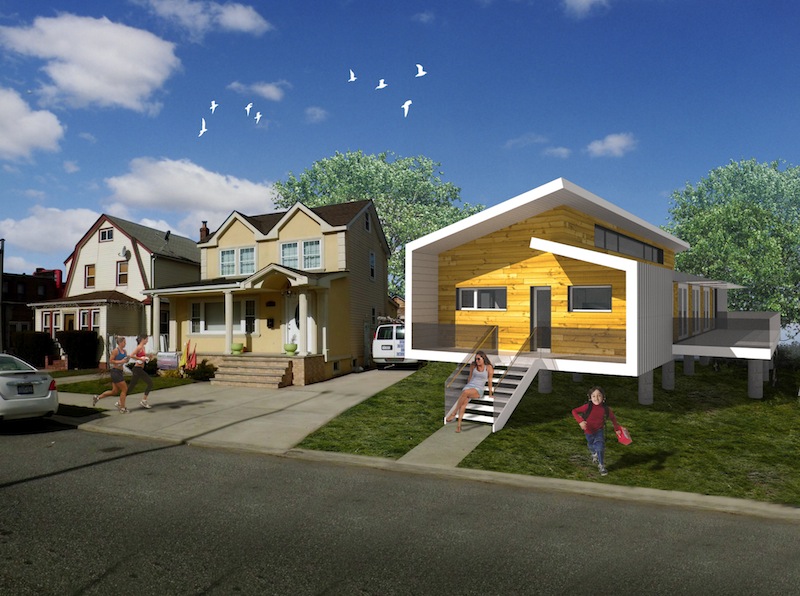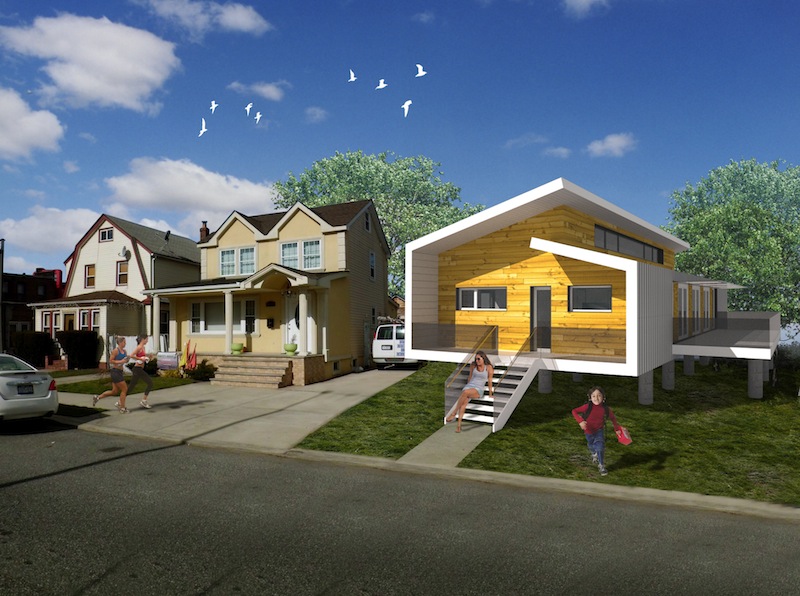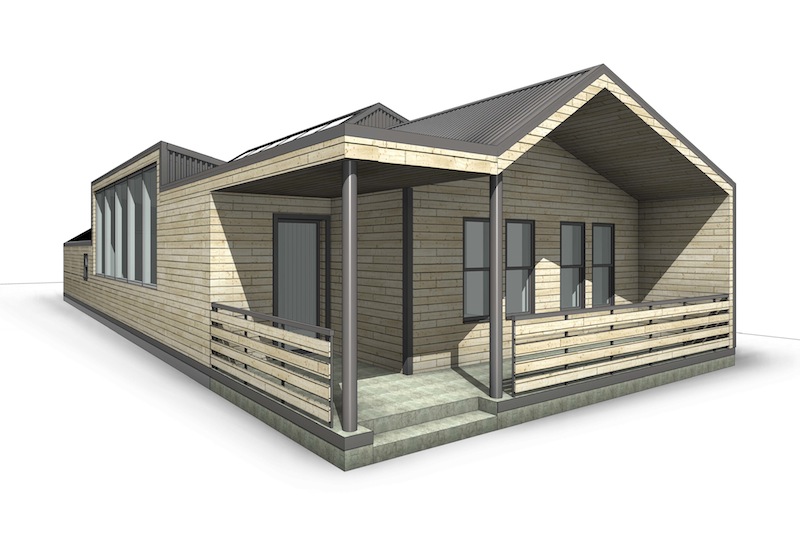The American Institute of Architects, in partnership with Make It Right, St. Bernard Project, Architecture for Humanity and Dow Building Solutions recently concluded “Designing Recovery,” an ideas competition created to aid in the rebuilding of sustainable and resilient communities. The competition was designed to help survivors of recent natural disasters in three distinct settings: New York City, New Orleans, and Joplin, Mo.
“When examining all of the designs submitted we continually asked ourselves if this would be a house we would want to live in regardless of safety considerations,” said Jury Chair, Michael Willis, FAIA, NOMA. “The three designs that we chose all had the ideal combination of addressing disaster mitigation and actual livability. The designs all had the sort of flexibility to be both a resilient safe haven during a natural disaster, but also serve as a dwelling that catered to family conditions and would blend into appropriate neighborhood styles without projecting a ‘bunker-like’ feeling.”
Although there could be just three winning designs, all of the entries that are feasible to construct will go into production in the corresponding communities and include:
1. Shotgun Remix
Designed by GOATstudio LLP, the Shotgun [remix] proposal for New Orleans offers a fresh, contemporary take on a familiar local typology. Modern touches like sliding polycarbonate privacy panels, vaulted interior spaces, clean, modern detailing, an open floor plan, and a steel roof that turns and wraps the southern exterior wall for additional sun protection update the historical shotgun form to better accommodate modern lifestyles and increased environmental challenges.
To help manage the threat from rising sea levels and increasing yearly rainfall, the finish floor will be elevated 7 feet above the ground plane and filter storm runoff through a perimeter rain garden, alleviating on-site ponding and reducing the load on strained city infrastructure. By employing similar construction methodologies and materials as those that have been thoroughly vetted by Make It Right since 2007, the design will be able to achieve LEED Platinum status and provide 6.25 kWh of solar energy to the owners.
2. Resilient House
Designed by Sustainable.TO Architecture + Building, the Resilient House for New York has a layout that orients living spaces towards the sun, and minimizes interior partitions. Structurally insulated panels allow for a tightly sealed and highly insulated building enclosure. Combined with a highly efficient ventilation system and upgraded windows, these design elements project to a 30% reduction in annual energy consumption. The house will be built above the floodplain with a flood-proof foundation to ensure natural disasters will not affect the structure. By using traditional construction methods and equipment, this dwelling can be built for less than $50,000 in material cost.
3. CORE House
Designed by Q4 Architects, CORE House in Joplin, MO is designed to address the local vernacular by combining two single-cell homes: a centrally located "Safe House" acts as the hearth and divides a "Perimeter House." The Safe House contains all of the functions of ‘home’ that are necessary for a family to recover quickly from disaster and live for an extended period of time until rebuilding is possible.
The walls of the Safe House are constructed of filled and anchored carbon-neutral concrete masonry units. Rainwater is collected, stored, and filtered for reuse. Locally sourced building materials were consciously considered so that CORE will have little impact on the progression of climate change, reduce the effects of debris in a natural disaster, and elevate local economies.
About The American Institute of Architects
Founded in 1857, members of the American Institute of Architects consistently work to create more valuable, healthy, secure, and sustainable buildings, neighborhoods, and communities. Through nearly 300 state and local chapters, the AIA advocates for public policies that promote economic vitality and public well-being. Members adhere to a code of ethics and conduct to ensure the highest professional standards. The AIA provides members with tools and resources to assist them in their careers and business as well as engaging civic and government leaders, and the public to find solutions to pressing issues facing our communities, institutions, nation and world. Visit www.aia.org.
About Architecture for Humanity
Architecture for Humanity is a nonprofit design services firm founded in 1999. By building a more sustainable future through the power of professional design, Architecture for Humanity taps a network of more than 75,000 professionals willing to lend time and expertise to help those who would not otherwise be able to afford their services. They bring design, construction and development services where they are most critically needed. For more information, please visit architectureforhumanity.org
St. Bernard Project
St. Bernard Project (SBP) is an award-winning rebuilding, nonprofit organization whose mission is to ensure that disaster-impacted citizens and communities recover in a prompt, efficient and predictable manner. Through its Disaster Recovery Lab, SBP works to share lessons learned, prevent common barriers to recovery, and help communities utilize SBP’s standardized, repeatable and proven-effective model. Since its founding in 2006, SBP has rebuilt homes for over 600 families in greater New Orleans, Louisiana and Joplin, Missouri with the help of 50,000 volunteers. In the wake of Hurricane Sandy, SBP is working on the ground in Rockaway and Staten Island, New York to help displaced families rebuild their homes and rebuild their lives. For more information, visit stbernardproject.org and sandy.stbernardproject.org.
Make It Right
Founded by Brad Pitt, Make It Right builds healthy, Cradle to Cradle-inspired homes, buildings and communities for people in need. Make It Right is currently working in New Orleans, LA, Newark, NJ, Kansas City, MO and the Fort Peck Reservation, MT. Learn more at www.makeitright.org.
Dow Building Solutions
Dow Building Solutions has a 60+ year legacy of providing energy saving solutions to the construction industry, which began with the launch of STYROFOAM™ Brand Extruded Polystyrene Foam Insulation. A business unit of The Dow Chemical Company, Dow Building Solutions offers insulation, air sealing and weatherization solutions to improve the performance of homes and buildings and reduce energy costs while contributing to the reduction of greenhouse gas emissions. Visit www.dowbuildingsolutions.com.
Related Stories
Construction Costs | May 31, 2024
Despite challenges, 2024 construction material prices continue to stabilize
Gordian’s Q2 2024 Quarterly Construction Cost Insights Report indicates that supply chain issues notwithstanding, many commodities are exhibiting price normalization.
University Buildings | May 30, 2024
Washington University School of Medicine opens one of the world’s largest neuroscience research buildings
In St. Louis’ Cortex Innovation District, Washington University School of Medicine recently opened its new Jeffrey T. Fort Neuroscience Research Building. Designed by CannonDesign and Perkins&Will, the 11-story, 609,000-sf facility is one of the largest neuroscience buildings in the world.
MFPRO+ New Projects | May 29, 2024
Two San Francisco multifamily high rises install onsite water recycling systems
Two high-rise apartment buildings in San Francisco have installed onsite water recycling systems that will reuse a total of 3.9 million gallons of wastewater annually. The recycled water will be used for toilet flushing, cooling towers, and landscape irrigation to significantly reduce water usage in both buildings.
Healthcare Facilities | May 28, 2024
Healthcare design: How to improve the parking experience for patients and families
Parking is likely a patient’s—and their families—first and last touch with a healthcare facility. As such, the arrival and departure parking experience can have a profound impact on their experience with the healthcare facility, writes Beth Bryan, PE, PTOE, PTP, STP2, Principal, Project Manager, Walter P Moore.
MFPRO+ News | May 28, 2024
ENERGY STAR NextGen Certification for New Homes and Apartments launched
The U.S. Environmental Protection Agency recently launched ENERGY STAR NextGen Certified Homes and Apartments, a voluntary certification program for new residential buildings. The program will increase national energy and emissions savings by accelerating the building industry’s adoption of advanced, energy-efficient technologies, according to an EPA news release.
Women in Design+Construction | May 28, 2024
Commerce Department launches Million Women in Construction Community Pledge
The U.S. Department of Commerce launched its Million Women in Construction Community Pledge this month to boost the ranks of women in construction companies. Federal investments are creating a construction boom that is increasing job opportunities for construction and trade workers.
Laboratories | May 24, 2024
The Department of Energy breaks ground on the Princeton Plasma Innovation Center
In Princeton, N.J., the U.S. Department of Energy’s Princeton Plasma Physics Laboratory (PPPL) has broken ground on the Princeton Plasma Innovation Center (PPIC), a state-of-the-art office and laboratory building. Designed and constructed by SmithGroup, the $109.7 million facility will provide space for research supporting PPPL’s expanded mission into microelectronics, quantum sensors and devices, and sustainability sciences.
MFPRO+ News | May 24, 2024
Austin, Texas, outlaws windowless bedrooms
Austin, Texas will no longer allow developers to build windowless bedrooms. For at least two decades, the city had permitted developers to build thousands of windowless bedrooms.
Resiliency | May 24, 2024
As temperatures underground rise, so do risks to commercial buildings
Heat created by underground structures is increasing the risk of damage to buildings, recent studies have found. Basements, train tunnels, sewers, and other underground systems are making the ground around them warmer, which causes soil, sand, clay and silt to shift, settle, contract, and expand.
Sports and Recreational Facilities | May 23, 2024
The Cincinnati Open will undergo a campus-wide renovation ahead of the expanded 2025 tournament
One of the longest-running tennis tournaments in the country, the Cincinnati Open will add a 2,000-seat stadium, new courts and player center, and more greenspace to create a park-like atmosphere.




















